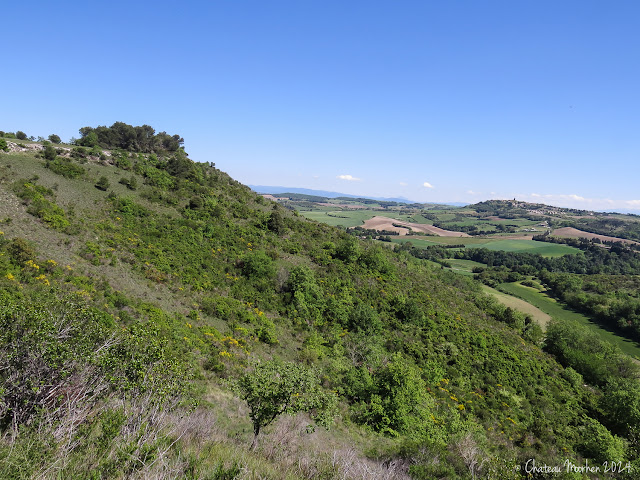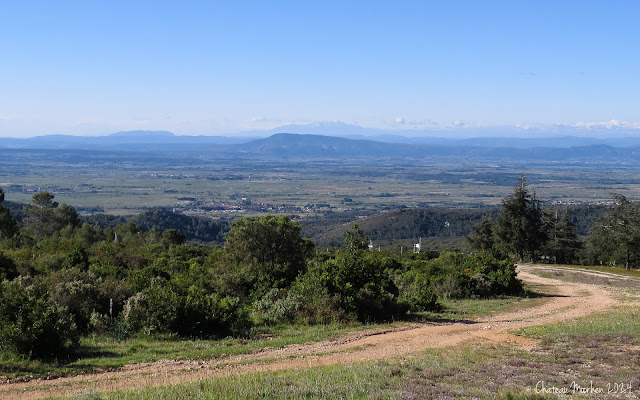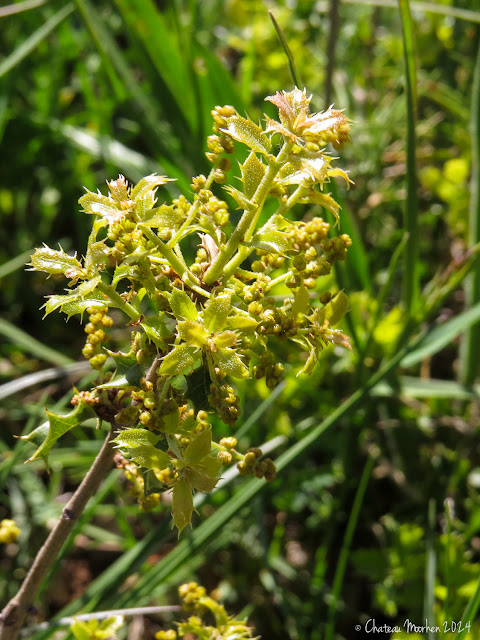This is certainly a good year for orchids! We have so many at home and some new ones too which is exciting.
Just along the road, on a steep bank below my neighbour's house (who, by the way, mowed off all those lovely Lady Orchids that I showed in my last post about orchids around here *rolls eyes*) I noticed a couple of orchids amongst the Lady Orchids which were different. I couldn't get close to them as the slope is way too steep to climb but my zoomed photos were good enough for them to be identified on our local Facebook group.
This is a Military Orchid (Orchis militaris), though sadly it's going over. Now last year I found one on the other side of the road, further along, and I've been looking for it this year, in vain. I don't mind where one pops up though and the nearer to my garden the better!
Then there was this one, which has been identified as a Lady x Military cross which, given there were about eight Lady Orchids here, makes sense. Maybe the Military Orchid was there last year but I didn't notice.
This is the hybrid orchid on the bank above a regular Lady Orchid (Orchis purpurea).
A picture of my lawn and this is even after I have removed dozens of labels! It's better if you click to view the photo larger as you can see the orchids clearer.
A big surprise this year was discovering the first Long-lipped Tongue Orchid (Serapias vomeracea) in our lawn! The poor thing has been mown when it was in bud so it is rather stunted, but hopefully it will spread seeds in time.
Maybe it came from this one which is in the verge outside our house which I discovered a few years ago. It’s the only one I can see in our road though, so these two feel extra special.
A closer look at the orchid lawn - the two main species flowering now, Man Orchids and Pyramidal Orchids.
Man Orchids (Orchis anthropophora) are interesting when you look at them close up. The man shape (the lip, or labellum) is like a childlike drawing of a man, with spindly limbs. They can have various colours on the lip, from cream to pale yellow and pink to red.
This one is cream at the bottom and dark pinky red at the top.
Pyramidal Orchid (Anacamptis pyramidalis).
We have eight Lizard Orchids (Himantoglossum hircinum) in bud in the lawn, and this one on the bank under our hedge outside, which is a first for there.
In the back garden we have loads of Early Spider Orchids (Ophrys sphegodes). The first ones appeared around March/April but these are a second flush, though are not the Late Spider Orchid, which is a different species!
The nectar bar is doing extremely well with many plants way too big! I pruned back that Sage in the middle by more than half at the end of winter, but it’s already as big as it was last year. And the Catmints are even bigger this year! I’m using link stakes to hold some plants away from others to stop them getting swamped.
There seems to be lots of interest in the flowers this year and I’ve seen my first ever Longhorned Bee and a Glanville Fritillary on the flowers this spring, amongst many others. Yesterday evening there were six Hummingbird Hawkmoths feeding at the same time - a fabulous sight!
The Pyracantha hedge is covered in flowers and just alive with insects. Butterflies love it as well as flies, bees, wasps and beetles. Below: Red Admiral (Vanessa atalanta).
Keith discovered this Glanville Fritillary (Melitaea cinxia) perched on a pool filter cover! It was happy to pose and then I took it on my finger and put it on a plant. I think it must have recently eclosed as it didn't seem to want to fly away.
For my birthday I asked for a bee hotel as we left our old one behind when we moved. This is a much bigger one, although it's not as deep so depending on how many eggs specific bees lay, they can always use more than one hole. I think he did a great job making it from odds and ends of wood that we had in the garage. 💜
For the moment I have put it behind a pillar on the patio where it is both in the shade and dry. Although I haven't seen any in action, we have had solitary bees nesting in little spaces in our shutters, including leaf cutter bees, so they must fly along this area. There are pots with flowers on the patio nearby, so hopefully they will find it. We will see! 😀
Keith remembered me getting excited about seeing a picture of some amazing spider brooches so kindly got me some of my own.
It was very sweet of him, although he didn't quite match the size of the originals (nor the price, I am sure!!!) worn by Queen Maxima of the Netherlands! Aren't they amazing? Apparently she has lots of insect jewellery. 😀
 Credit Hello Magazine
Well there you go, a long post to finish on. We did go on an amazing botanical/orchid day out recently with our birding group, but I have so many photos that I will leave that blog post until after our holiday! For now, I am out of here as my brother is coming at the weekend and I need to get the house cleaned and the moho ready for our upcoming holiday. See you anon. 😁
Credit Hello Magazine
Well there you go, a long post to finish on. We did go on an amazing botanical/orchid day out recently with our birding group, but I have so many photos that I will leave that blog post until after our holiday! For now, I am out of here as my brother is coming at the weekend and I need to get the house cleaned and the moho ready for our upcoming holiday. See you anon. 😁
Mont Carrière isn't a mountain, it's just a hill no higher than our own village, which is only a few kilometers away. It's known for its wild orchids and we have visited several times, and I blogged about it in 2021 when we visited in April. It was interesting this time to see it a month later, with different plants in bloom.
As we didn't fancy the long uphill walk, we decided to drive partway up the farm track as we have 4-wheel drive. When we got to a place where we could park, we discovered there was another field entrance, this one leading to a tarmac road (albeit a very small, rough lane). It turned out we could have avoided the rough track coming up this way, as we discovered driving home on the proper road! It's in the Faves of our SatNav now. 😀
Looking towards our village, Fanjeaux.
What I love so much about this area is that initially we were walking along beside arable fields on a brown dirt track with long rough grass on the sides, when suddenly the brown dirt on the track gave way to white chalk and the long grass gave way to garrigue vegetation, particularly on the south facing slope - Rosemary, Thyme, Lavender, Curry Plant and much more. The decidious trees up here were mainly Downy Oak (Quercus pubescens) which likes dry limestone soils in a Mediterranean-Oceanic Climate, which is pretty much what we have here.
Fanjeaux from Mont Carriere, a green Tiger Beetle (Cicindela campestris) and a Glanville Fritillary (Melitaea cinxia).
As far as orchids were concerned it was a little disappointing, as whilst there had been a nice selection of orchids in April, in May there were only two orchid species coming into bloom that we could find. Below is the Long-lipped (or Ploughshare) Tongue Orchid (Serapias vomeracea).
And this is the Pyramidal Orchid (Anacamptis pyramidalis). We have both these species in our lawn!
Looking towards the plateau at the top of Mont Carrière, with Fanjeaux to the right and the Corbieres hills in the far distance.
There were tons of Owlflies flitting about, although they are quite hard to photograph as they don't stop for long when they do perch! Keith's photo has a nicer background than mine. This species is called the Owly Sulphur (Libelloides coccajus). Owlflies are part of the insect order Neuroptera, which includes the Lacewings, Antlions and Mantisflies - in my opinion some of the coolest insects to be found!
Photo credit: Keith Allen
Because this is an orchid walk, there were a number of info boards showing different species found here.
Wild Gladioli (Gladiolus illyricus), a gorgeous Barbie pink, though this specimen was past it's best. It was the only one I could get close to though.
On the plateau we remembered there being lots of Swallowtails the previous times we visited, and there were still plenty flying around, this Scarce Swallowtail (Iphiclides podalirius) and also the regular Swallowtail (Papilio machaon).
Photo credit: Keith Allen
On the highest part of the plateau there is a 360 degree view and these info boards showing what is in each of the four directions is really handy, naming all the hills and mountain peaks. Here we are looking towards the Montagne Noir. We could see the Pyrenees on the opposite side, but the clarity wasn't great (it is at its best in winter).
This is a really pretty plant - it is Dropwort, or Fern-leaf Dropwort (Filipendula vulgaris) which is closely related to Meadowsweet, another Filipendula. It likes dry pastures and chalky soil.
Rosy Garlic (Allium roseum), a wild garlic of the Mediterranean region.
Another view looking towards Fanjeaux with a bit of the Pyrenees to the right and the Corbieres to the left, and garrigue plants in the foreground.
On our return, once back into the grassy arable area, we spotted a few of these delightful Narbonne Star-of-Bethlehems (Ornithogalum narbonense). I love the stripy buds!
I just love this time of year! We will be away for three weeks in June, going all around the Pyrenees on both the Spanish and French sides, so I am looking forward to the mountain wildflowers and hopefully lots of butterflies! I have one more post to go after this but I will probably go quiet for a while after that.
After lunch we headed a bit west and higher up to a place Gill calls the Magic Meadow. On the way we passed areas covered in the Papillon or Butterfly Lavender (a good indicator of acid soil). Rocky verges gave way to grassy ones full of Cowslips, then swathes of Early Purple Orchids (Orchis mascula) appeared, like these below.
The last time we were here we walked several kms uphill, but this time, thankfully we drove that bit after carpooling at Pech Mégé, altitude 637m. Then it was a shortish walk to where we disappeared into some trees and emerged on the side of a limestone ridge.
This area is amazing for having a mix of Mediterranean and mountain species, at an altitude of about 700m, which is not particularly high for mountain plants.
This photo, taken by Keith, is an indicator of what it's like on a wildflower trip. Bums in air! All the photos K took of me by the way, I had my back to the camera and my hood up (that's me on the right). It was FREEZING up there and when the sun went in it was even worse. There were times when I was nearly blown off my feet.
Here we are looking in the direction of the plain , on the other side of which are the Pyrenees.
And this is the other side of the ridge that we were on.
There were occasional lovely little sheltered spots like here, just covered in Early Purples and Rush-leaved Narcissi, the same little Narcissus that we saw in the morning. In a place like this, it’s hard to not tread on a flower, so we did our best to avoid the orchids, knowing that the thyme and other low ground cover plants could mostly take our footsteps.
In a sheltered spot we found the only two Fly Orchids (Ophrys insectifera) of the day. The two flowers that were out show just how varied Ophrys species can be in terms of colour and markings.
This is a cute little mountain species, Creeping Globularia (Globularia repens).
My favourite plant of the day is this lovely little alpine, Hairy Rock Jasmine (Androsace villosa). Several websites I read said that this species is found from an altitude of 1,200m, showing how interesting it is in the Magic Meadow, as we were about 500m lower down than that.
In the top right of the picture is Mountain Kidney Vetch (Anthyllis montana) with pinky red flowers.
And in this picture is Common Kidney Vetch (Anthyllis vulneraria), although both species can be found at altitude.
There were other wildflowers worthy of photos but
by this time my knees had just about given up! I saved my last bit of
strength for anything amazing, like this Sword or Narrow-leaved Helleborine (Cephalanthera longifolia) which we saw in a shady spot on our way back.
On the way back to the cars it started snowing!!! Unbelievable! It was only light fine snow, but even so. We called it a day earlier than we normally would have because everyone was cold and fed up of the wind by now. I sat in the car and enjoyed a nice warming cup of tea from our flask.
Just after we left K decided to take his jacket off, so we pulled in and I saw these Aphyllanthes monspeliensis - they are a common plant on the garrigues in spring and on grassy hillsides around where we live. I didn't see any during the day however.
Other orchids seen during the day, and the reasons for not taking pics, were:
Early Spider Orchid (in my lawn!)
Yellow Bee Orchid (in my lawn!)
Man Orchid (in my lawn!)
Tongue Orchid (already have many photos and knees were giving way)
Dense Flowered Orchid (I have photos from the last time we were there, plus knees)
Woodcock Orchid (I missed that one)
Violet Limodore in bud (I missed that too sadly, but it was growing along the verge a bit lower down from where we parked. Not one I have seen before).
I went back through my 2021 photos, as I never posted about that trip on my blog. Here's a photo giving you an idea of what the Magic Meadow looked like a month later, in mid May. Not really a lot different, apart from a sea of yellow everywhere from a yellow Rock-rose.
This is the plant in question: a Rock-rose that I can't ID (Helianthemum sp.). PlantNet isn't much help as there are three that look similar but not quite right!
It was a very successful day in terms of wildflowers but somewhat challenging with the weather! Having seen these two spots in both April and May, I would like to come back in June to see what else might be in flower - but I would choose a nice day and hope to see lots of butterflies!
This was a wildflower outing organised by Birding Languedoc last week, one that we had done before in May 2021. We started the day above the village of Siran in the Minervois. Due to firebreaks keeping the vegetation down it has allowed the wildflowers room to flourish without competition from the nearby trees and shrubs. This is garrigue habitat, where most plants grow low to the ground in rocky free draining soil, where they cope with hot dry summers due to small tough leaves, and/or summer hibernation.
There were only seven of us on the trip: Philippa who leads the BL trips and Gill who was our plant expert for the day. Also present were a couple of guys I know who are pretty knowledgeable about plants/birds/insects, so it made for an easier day with most plants fairly readily identified.
Whilst we had some great views over the plain to the Corbieres and distant Pyrenees, it was a very windy day so we were blasted by the cold wind until we could get to some more sheltered spots!
Being here a month earlier than the last time allowed us some fabulous displays of Asphodels (I don't know species name, possibly Asphodelus cerasiferus?. Edit: Though I see from my photos that some of them are Branched Asphodels (A. ramosus)).
My favourite garrigue plant is Cistus, particularly this Grey-leaved Cistus (Cistus albidus) with its lovely crinkly pink flowers. Also in this image is Thyme (Thymus vulgaris) which was everywhere, and Curry Plant. I hadn't realised that Curry Plant can be either Helichrysum italicum or H. stoechas. I thought they were one and the same plant! I can't tell which exact species were the ones we saw, that's impossible!
One of the stars of the day were these Pyrenean Fritillaries (Fritillaria pyrenaica).
Clockwise from top left: Rush-leaved Narcissus (Narcissus assoanus), Common Storksbill (Erodium ciconium), Perennial Lettuce (Latuca perennis) and White Rock-rose (Helianthemum apenninum).
A giant Puffball fungus well past its best.
Young shoots and flower buds of Kermes Oak (Quercus coccifera), the low growing oak found on garrigue habitat.
Thyme
We saw quite a lot of these Green-winged Orchids (Anacamptis morio) which were growing out in the open (photo on left), but only very few Provencal Orchids (Orchis provincialis) in more sheltered spots.
More Asphodels and Grey-leaved Cistus.
Our hardy wildflower loving group. 😀
We had our picnic in a sheltered spot nearby which was the only place where I saw butterflies, although one of our group spotted a few brave flutters hugging the ground during the day.
The afternoon's finds will be in part 2.





























































